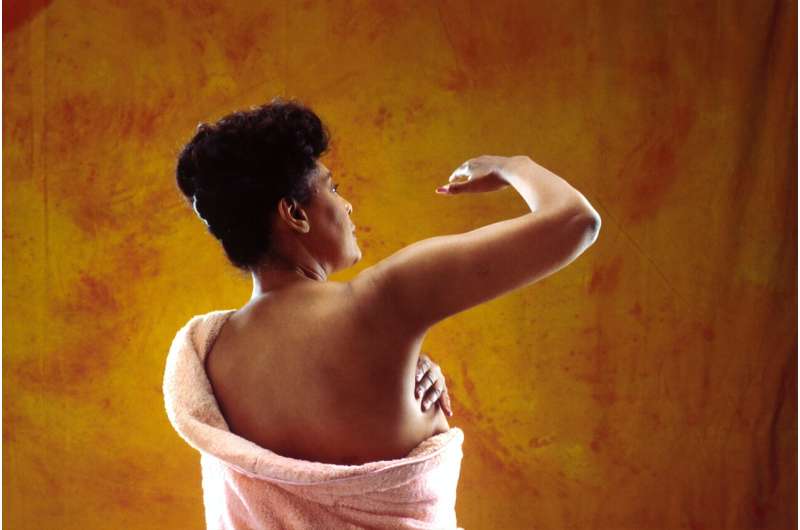
Credit: Unsplash/CC0 Public Domain
Breast cancer is the most commonly diagnosed cancer among American women and the second leading cause of cancer death. Black women who develop breast cancer are about 40 percent more likely to die from the disease than white women, but it has been unclear whether this disparity applies to all types of breast cancer.
Now, a meta-analysis led by researchers at Mass General Brigham shows that black women have a higher risk of dying from breast cancer, regardless of tumor type. The magnitude of this difference ranges from 17 to 50 percent, depending on the type of breast cancer.
These findings, published in the Journal of Clinical Oncology, demonstrate that higher mortality rates among Black women with breast cancer are at least partly attributable to factors independent of tumor biology, such as socioeconomic inequality, delays in diagnosis, and inadequate access to timely, quality cancer treatments due to systemic racism.
“Our findings show that multiple, interacting factors contribute to the disparities in breast cancer survival between black and white women,” said lead author Erica Warner, ScD, MPH, a cancer epidemiologist at Massachusetts General Hospital, a founding member of the Mass General Brigham health system.
“To achieve equity, interventions are needed at multiple levels: from the community to health systems and individual health care providers, to patients themselves learning more about their disease and what their expectations of care should be.”
Although often discussed as a single disease, breast cancer has multiple subtypes that differ in risk factors, treatment, and prognosis. These subtypes are defined based on whether the cancer cells carry hormone receptors for estrogen or progesterone, which can be targeted for treatment, and whether they carry HER2 (human epidermal growth receptor 2), a protein associated with cancer aggressiveness and another potential treatment target.
“There was an anecdotal sense in the research community that the survival gap between black and white women was greater for the most treatable forms of the disease — tumors that carry hormone receptors — and smaller for the historically less treatable, hormone-negative tumors,” Warner said.
To investigate whether these anecdotes were supported by the evidence, Warner’s team combined data from 18 studies published between 2009 and 2022. In total, these studies analyzed 228,885 breast cancer cases, 34,262 of which were in black women.
They found that survival was worse for black women across all breast cancer subtypes, although the magnitude of these differences varied across breast cancer subtypes. There was a greater racial disparity for hormone-positive tumors, which were associated with a 34-50% higher risk of death for black women, compared with hormone-negative tumors, which were associated with a 17-20% higher risk of death for black women.
“These findings underscore a stark reality in our health care system: Black women are at higher risk of dying from breast cancer compared to their white counterparts, regardless of the type of disease. This disparity is not just biological,” said co-author Paulette Chandler, MD, MPH, associate epidemiologist in the Division of Preventive Medicine at Brigham and Women’s Hospital, a founding member of the Mass General Brigham health system.
“It is a call to action for healthcare providers, policymakers, and communities to address these disparities head-on and strive for meaningful change in breast cancer outcomes.”
Because hormone-negative tumors are less common, Warner said it is likely that survival differences among hormone-negative breast cancer subtypes were not observed previously because the individual studies were statistically underpowered due to the small number of cases.
“There may also be differences in the biological characteristics of some tumor subtypes between racial groups that our therapies are not tailored to, possibly due to the underrepresentation of Black women in clinical trials,” Warner said.
These racial disparities are not inevitable, however. The researchers point to several existing multi-level intervention programs that have successfully reduced cancer survival disparities.
These programs use multiple strategies, including helping patients navigate the care system, proactively identifying social needs and connecting patients with resources that can meet those needs, and implementing systems that alert providers to missed appointments or unmet care milestones.
At national level there are interventions such as ACCURATE And Equal hope aim to close the gap in mortality and survival rates between black and white women.
Locally, MGH is partnering with Boston Medical Center to create a virtual Cancer Treatment Equity Hub to strengthen partnerships and improve cancer care for underserved patients in community-based mental health centers.
More information:
Racial disparities in breast cancer survival between black and white women by tumor subtype: a systematic review and meta-analysis, Journal of Clinical Oncology (2024). DOI number: 10.1200/JCO.23.02311
Quote: Black women higher risk of dying from all types of breast cancer, meta-analysis finds (2024, September 17) Retrieved September 17, 2024 from https://medicalxpress.com/news/2024-09-black-women-higher-dying-breast.html
This document is subject to copyright. Except for fair dealing for private study or research, no part may be reproduced without written permission. The contents are supplied for information purposes only.
 Healthy Famz Healthy Family News essential tips for a healthy family. Explore practical advice to keep your family happy and healthy.
Healthy Famz Healthy Family News essential tips for a healthy family. Explore practical advice to keep your family happy and healthy.


